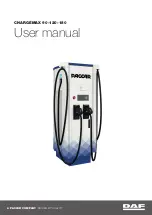
Technician Service Guide 33367B
6
If the measured voltage increase on the batteries
indicates the full on-charge voltage when the
charger turns on, the source of the high resistance
must be corrected to obtain proper charging.
Rework bad connections on batteries or replace bad
battery cables and/or batteries.
If the measured voltage increase on the batteries
indicates normal rise, perform the same test where
the WHITE (+) DC cord lead connects (test point E)
and the BLACK (-) DC cord lead connects (test point
F) in the charger, see figure 1. If the measured
voltage increase indicates the full on-charge voltage
when the charger turns on, correct the source of the
high resistance. Repair or replace the charger DC
cordset, equipment charging receptacle and/or
equipment wiring.
Inspect and test charger DC circuit.
If the measured battery system voltage increase on
the batteries and at charger test points E and F
indicate normal operation, disconnect both the AC
power plug from the outlet and the DC plug from the
equipment charging receptacle.
Inspect and make sure all connections to the
fuse/circuit breaker, shunt and ammeter, if equipped,
are secure and tight.
If the charger being serviced has an ammeter and
the needle did not deflect but the charger passed the
“
Test for battery voltage increase”
, replace the
ammeter with the replacement service part specified
on the parts list for the specific model of charger
being serviced and retest.
If the charger being serviced does not have an
ammeter and the charger passed the “
Test for
battery voltage increase”
or replacement of the
ammeter did not correct the problem, measure
continuity of the charger’s DC circuits.
Place one test lead of continuity meter where the
WHITE (+) DC cordset lead connects (test point E)
and the other test lead of the continuity meter on the
SCR side of the shunt, to measure the positive
output side. If continuity is not measured, rework
connections to the shunt and/or replace failed shunt
and retest.
To measure the negative output side, place one test
lead of the continuity meter where the BLACK (-) DC
cordset lead connects (test point F) and the other
test lead of the continuity meter on the SCR side of
the DC fuse/circuit breaker. If continuity is not
measured, rework connections to the DC fuse/circuit
breaker and ammeter, if equipped, or replace failed
DC fuse, fuseholder/circuit breaker and/or ammeter,
as needed and retest.
If the charger passes both the “
Test for battery
voltage increase”
and “
Inspect and test charger
DC
circuit
” proceed to
Section 3, Part A, Test for
correct transformer output coil voltage.
If the
transformer output coil voltage test indicates a failed
transformer, retest charger for proper operation after
transformer replacement. If the transformer passes
the output coil voltage test or the charger still has no
output after transformer replacement, the electronic
timer must be repaired or replaced.
WARNING: ALWAYS TEST SCRs BEFORE
REPLACING AN ELECTRONIC TIMER. DAMAGE
AND SUBSEQUENT FAILURE WILL OCCUR TO
ALL ELECTRONIC TIMERS INSTALLED IN A
CHARGER THAT CONTAINS A SHORTED
ANODE TO GATE SCR, IF CONNECTED TO AC
POWER.
For SCR testing instructions, see
Section 4, SCR
testing procedure.
Part C
Indicator light(s) illuminate, charger produces
output but ammeter does not deflect.
If the charger is known to be producing output
current, by performing the
Test for battery voltage
increase, Section1, part B
or by measuring output
current with an external ammeter, but the charger’s
ammeter needle doesn’t deflect, replace the
ammeter with the replacement service part listed on
the parts list for the specific model of charger being
serviced.
SECTION 2 – CHARGER DOES NOT TURN OFF
This malfunction symptom may be due to factors
other than the charger’s performance, such as bad
batteries or charging larger capacity batteries than
the charger is rated for. Chargers with a fault light
will indicate a “maximum charge time exceeded”
fault.
Bad batteries may not allow the battery system to
obtain an overall gassing point voltage, which is
approximately 2.25 volts per cell. (2.25 volts per cell
X the number of cells in the battery system = battery
system gassing point voltage) The electronic timer
monitors the batteries for a full charge condition after
the battery voltage reaches the gassing point. Verify
the battery system is capable of reaching the
gassing point voltage. If the batteries cannot reach
the gassing point voltage, the useful life of the
batteries has ended and replacement is required.
Verify the charger is providing the charge rate
specified on the charger nameplate, DC AMPS, at
the start of the charge cycle (battery voltage below 2
volts per cell). If the charger does not output the
specified amount of DC amperes, see
Section 1,
Part B, Test for battery voltage increase
and
Section 4 SCR Testing.
If a lower than specified






























